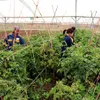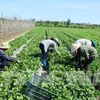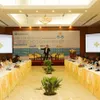AEC beckons more competitive business environment
by ,http://vietnamnews.vn/economy/464393/aec-beckons-more-competitive-business-environment.html23 August 2018 Last updated at 08:59 AM


|
| Minister of Industry and Trade Trần Tuấn Anh. |
This year marked the 51st anniversary of the Association of Southeast Asian Nations (ASEAN) and the 23rd anniversary of Việt Nam’s accession to the bloc.
Minister of Industry and Trade Trần Tuấn Anh spoke to the Vietnam News Agency about Việt Nam’s cooperation with member countries of the organisation in recent years and targets for the future, especially economic co-operation.
Could you tell about the establishment and development of the ASEAN Economic Community?
ASEAN was established on August 8, 1967 in Bangkok with the aim of building and maintaining economic development co-operation, sharing common prosperity and ensuring peace and stability in Southeast Asia.
Founders of ASEAN included Indonesia, Malaysia, Philippines, Singapore and Thailand under the signing of the ASEAN Declaration. During the expansion of ASEAN, Brunei joined the organisation on January 8, 1984. Việt Nam joined on July 28, 1995, Laos and Myanmar joined on July 23, 1997 and Cambodia joined on April 30, 1999.
After 51 years, ASEAN consists of 10 members and is the third largest market in Asia with over 650 million people, accounting for 8.59 per cent of the total population. This bloc’s GDP per capita has reached US$4,305. It is expected to double by 2030, making ASEAN the seventh-largest economic community in the world with a total GDP of $2.766 trillion.
Over the past 50 years of co-operation and development, besides security, political, cultural and social cooperation, ASEAN has been focusing on economic co-operation through the establishment of the ASEAN Economic Community. This economic co-operation is considered one of the most important things to support the development of each ASEAN member.
Apart from intra-ASEAN co-operation, ASEAN has also strengthened links and cooperation with important partners such as ASEAN+3, ASEAN+ 6 in many areas of infrastructure, trade in goods and services, technology, value chains and comprehensive connectivity for institutions, infrastructure and people.
Could you share more about the important achievements in economic co-operation that ASEAN has achieved in recent years?
According to the commitments of the ASEAN Trade in Goods Agreement (ATIGA), ASEAN countries are closer to the target of eliminating most tariff barriers for ASEAN 6 (five ASEAN founders and Brunei). About 99.2 per cent of the tariff lines have been removed while 90.9 per cent of the tariff lines of countries that joined ASEAN later, including Cambodia, Laos, Myanmar and Việt Nam (CMLV), were eliminated by 2017.
By the end of this year, the tariff lines that are eliminated for all ASEAN countries will reach 98.67 per cent.
In addition, Việt Nam and other ASEAN countries have implemented the mutual recognition agreement (MRA) on electricity and electronics, and on the inspection of good manufacturing practices. Việt Nam and those countries have signed the MRA on biological equivalence studies and certificate of food safety for processed food, creating an ASEAN production area.
At the same time, the liberalisation of trade in services is one of the important priorities for the ASEAN Economic Community.
At present, ASEAN countries are aiming to finalise negotiations and sign a protocol implementing the 10th package of the ASEAN Framework Agreement on Services (AFAS-10) in 2018.
Up to now, ASEAN has signed and implemented six FTAs including the ASEAN Free Trade Area (AFTA) and five FTAs between ASEAN and its partners, China, South Korea, Japan, India, and Australia-New Zealand.
In November 2017, ASEAN countries also signed the ASEAN-Hong Kong (China) Free Trade Agreement and the ASEAN-Hong Kong Investment Agreement.
At present, ASEAN member countries are also negotiating the Comprehensive Economic Partnership Agreement (RCEP) with six partner countries, including China, South Korea, Japan, India, Australia and New Zealand. Those agreements will have higher commitments than those in current FTAs.
Over the past 50 years, the total trade value in goods of ASEAN countries with the world has increased by $10 billion per year to $2.575 trillion in 2017. Meanwhile, total trade value in services has increased from $140 billion in 1999 to a record $681 billion in 2016.
In 1995, to deal with strong competition in attracting foreign direct investment (FDI) with other developing countries, ASEAN established the ASEAN Investment Area (AIA). It is expected to encourage FDI to the ASEAN region, where young, cheap and abundant workers are available.
Therefore, ASEAN has become an attractive destination for foreign investment, with total capital worth at $137 billion in 2017, a strong growth against the volume of $22 billion in 2000 and $13 billion in 1967.
The services sector has accounted for the largest volume of the total FDI to ASEAN, increasing from 50.8 per cent in 1999 to 80.8 per cent in 2016. Following are industry, energy and agriculture.
FDI to ASEAN has mainly come from the European Union, Japan, China, South Korea and Australia.
Japanese investors are interested in industrial manufacturing with investment capital of $23.8 billion, while Chinese investors have focused on finance, wholesale and retail, shipping and the real estate sectors. Australian, EU and US investors are interested in services, especially financial services.
Intra-regional investment also rose to a record $24 billion in 2016, accounting for a quarter of FDI in the region.
How has Việt Nam’s export value changed since joining the ASEAN Free Trade Area (AFTA)?
Since joining the AFTA in 1996, the total trade value between Việt Nam and ASEAN has increased about 7.7 times, from $5.91 billion in 1996 to $45.23 billion in November 2017.
Of which, Việt Nam’s export value to ASEAN increased by 12.4 times, from $1.6 billion in 1996 to $19.9 billion. By the early of July 2018, the total trade value had reached $28.1 billion, including $12.2 billion in export value and $15.9 billion in import value.
Entering 2018, Việt Nam will cut tax rates on 98 per cent of tariff lines with ASEAN countries under the ATIGA.
What must Việt Nam do to achieve targets of ASEAN 2018 as well as to prepare for 2020 when Việt Nam is the chair of ASEAN?
Việt Nam will continue to closely co-ordinate with other ASEAN countries to implement the ASEAN Economic Community (AEC)’s Strategic Action Plan 2025 (SAP).
On the other hand, the nation will co-operate with ASEAN countries to further review and implement commitments in ASEAN+1 FTAs. Of which, ASEAN countries will review the second phase of the ASEAN and Australia-New Zealand FTA (AANZFTA) and implement working programmes with other ASEAN partners.
In 2018, Việt Nam will chair the 10th CLMV Economic Ministers’ Meeting held on the sidelines of the ASEAN Economic Ministers’ Meeting in Singapore.
To take full advantage of the opportunities from the ASEAN Economic Community by 2025 and preferential policies from ASEAN’s FTAs, Vietnamese enterprises need to improve their competitiveness, find a reasonable product structure, and raise awareness on Việt Nam’s rights and obligations.
During ASEAN economic integration, ministries and sectors should enhance their co-ordination and improve mechanisms for the participation in technical meetings to save resources. — VNS





